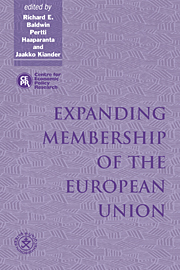Book contents
- Frontmatter
- Contents
- List of figures
- List of tables
- Preface
- Acknowledgements
- List of conference participants
- 1 Introduction
- PART ONE THEORETICAL ISSUES
- 2 A domino theory of regionalism
- 3 Customs unions, regional trading blocs and welfare
- 4 Consumer services and economic integration
- PART TWO POLICY ISSUES
- PART THREE EMPIRICAL ISSUES
- Index
4 - Consumer services and economic integration
Published online by Cambridge University Press: 05 November 2011
- Frontmatter
- Contents
- List of figures
- List of tables
- Preface
- Acknowledgements
- List of conference participants
- 1 Introduction
- PART ONE THEORETICAL ISSUES
- 2 A domino theory of regionalism
- 3 Customs unions, regional trading blocs and welfare
- 4 Consumer services and economic integration
- PART TWO POLICY ISSUES
- PART THREE EMPIRICAL ISSUES
- Index
Summary
Introduction
One common criticism of economic integration is that while integration can increase welfare in price terms it may lead to a deterioration in the non-price terms of consumption. Geroski (1989), for example, has argued that integration may reduce the variety of goods available to consumers if economies of scale in production are strong. At the policy level, Finnish and Swedish governments during the EU membership negotiations demanded the right to continue their present regional policies to ensure the availability of services everywhere (Ministry of Foreign Affairs, 1993). Indeed one of the hardest issues in the negotiations during spring 1994 was which areas in Finland and Sweden were entitled to receive special funding from the EU regional programme. In this chapter we study these issues by looking at how the quality of consumer services is affected by economic integration. Another issue on which we hope to shed some light is whether one can expect the relative prices of basic consumer goods to fall when the restrictions on the imports of these goods are lifted. In the light of the fact that the relative prices of food products, for example, are highest in the OECD area among Nordic countries, one major argument in favour of EU membership has been an expected decline in related consumer prices.
This point of view is relevant also to the integration theory in general, since almost all the goods traded internationally reach consumers via a distribution system and the distribution sector (comprising only a part of consumer services) is a sizable sector in itself.
- Type
- Chapter
- Information
- Expanding Membership of the European Union , pp. 80 - 110Publisher: Cambridge University PressPrint publication year: 1995
- 1
- Cited by



